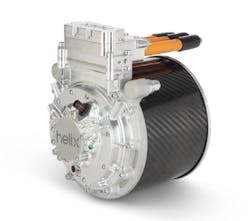Don't Do It: Ignore Radial-Flux Motors for Top-End Mobility
What you'll learn:
- The rise of axial-flux motors.
- Motor theory versus practice.
- Scalability of axial- and radial-flux motors.
- The future motor split.
Many technologies have played a role in the electric-vehicle (EV) boom. Innovations in batteries, materials, power electronics, and controls have all been crucial in enabling EVs to compete with combustion vehicles in terms of affordability, weight, and range.
One of the most impactful innovation areas for EVs has been advances in motors, with this century seeing major improvements in motor efficiency and power density. These developments have been critical to delivering the compact and affordable electric powertrains that underpin widespread EV adoption.
The quest for ever more affordable and long-range EVs isn’t abating, though. And many sectors beyond automotive are interested in electrifying, such as industrial equipment, marine, and aerospace. So, the pressure is on engineers to maintain the relentless pace of motor innovation we’ve seen over the past decades.
The Rise of Axial-Flux Motors
How exactly can the next generation of motors keep up the pace in terms of improving efficiency and power density? For teams that need to develop the most compact, high-performance systems, one of the most popular answers has been revisiting their motor architecture.
Most motors currently residing in EVs are radial-flux (RF) architectures (see figure). This means that the rotor and stator exist as two cylinders, one sitting within the other. Therefore, the magnetic flux between the two runs perpendicular to the axis of rotation—that is, “radially.”
To deliver high torque in a short package length, some teams are instead investigating axial-flux (AF) architectures. In these systems, the stator and rotor exist as discs alongside each other, meaning that the magnetic flux running between the two is “axial.”
An AF motor has a flat, disc-like form that allows it to be deployed in applications where length is constrained. Because of its geometry, an AF system’s “air gap”—the gap that exists between the rotor and stator—can have a larger radius and, in short motors, have greater surface area. These two things together mean more work could be done. It also suggests the possibility of AF systems achieving higher power density.
This has led to speculation that the future of motor design is going to see AF architectures dominate the top rungs of power density. But is this the case?
Motor Theory vs. Practice
AF motors bring their own challenges to the table, relative to RF architectures.
Permanent-magnet rotors are magnetically attracted toward stators. Within a RF system, this attraction is cancelled out, or “balanced,” because it’s equal in every direction. But in an AF system, this attraction would cause the stator and rotor to stick together if not counter-balanced or resisted.
>>Download the PDF of this article
To cancel out the attractive force and avoid some complexities with resisting the unbalanced force with bearings, AF systems either sandwich a single stator within two rotors, or a single rotor between two stators.
Most of the interest in AF systems has gone into double-rotor architectures, since they’re “yokeless”—they don’t need a large block of iron surrounding the system to ensure the magnetic circuit is completed. Instead, these yokeless AF motors require duplication of some of the most expensive materials within the system: the magnets, permeable rotor “back-iron,” and rotor structure.
However, a problem confronting these AF systems is that they introduce a second air gap. The thickness of the air gap is the dominant source of reluctance in a magnetic circuit. Like resistance in an electrical circuit, this reduces the potential power output of the system. Consequently, compared to an RF system, an AF motor must face almost twice the reluctance for a given air-gap thickness.
Because of geometry, an AF system can be competitive for short motors. However, beyond these, AF motors face some significant practical implementation challenges owing to the double air gap.
Ensuring both air gaps in an AF motor are balanced across a range of temperatures, vibration levels, and rotordynamic conditions is very difficult, compared to the single air gap in an RF system, especially considering challenges around production tolerances. And balance is key for performance, along with mitigating risk of catastrophic failure via direct contact between rotor and stator.
Scalability of AF and RF Motors
A key area of difference between AF and RF is that of scalability in production. For both AF and RF machines, much of the manufacturing tooling relates to the diameter of the motor, and less to the length.
For example, if an application requires 50% more torque, then it’s possible to simply extend the active length of an RF motor by 50%. This would double the surface area of its air gap and deliver a torque increase. Plus, it would require little change in tooling or production.
However, this isn’t possible for an AF system. There are two options to add 50% more torque for an AF system:
- Add a complete second AF motor. This means twice the individual motor components, along with a second inverter.
- Increase the diameter of the AF motor. However, it will require a complete change in production tooling.
The Future Motor Split
It’s become commonplace to believe that the direction of travel is the ironing out of the practical problems associated with AF, to the point where they’ll supplant RF as the most power-dense systems on the market.
In this story, the idea is that AF will dominate high-density, high-performance applications at the mobility frontier. On the other hand, RF will serve as the cheaper alternative for vehicles and drive systems where power density doesn’t matter as much.
But is this accurate? It’s worth remembering that RF development isn’t stagnant—there’s plenty of room for innovation to push these motors closer toward their own theoretical performance ceiling. And this is reflected on the ground, with state-of-the-art RF systems continuously improving from a baseline that’s already ahead of AF in terms of power density and efficiency.
For example, one of the biggest challenges—and opportunities—for further development in power density, for both RF and AF architectures, is that of cooling. It’s a challenge that engineers are nowhere near fully solving, yet the technology is seeing some of its biggest forward strides being made.
That's because the broader e-mobility revolution increasingly brings engineers with backgrounds beyond electronics to the table. Ironically, it’s teams that can draw on thermal-management insights from combustion systems may have a particular edge.
The transition to electric mobility means that many engineers who have spent their careers working on combustion-engine systems are now pivoting to EVs. Given how important thermal management is to combustion-vehicle design, we should expect some real strides in RF cooling to come from this in the coming years.
And this just looks at questions of cooling and thermal management. It doesn’t mention other innovation categories that can further drive down losses, such as new geometries or winding configurations. Along with thermal expertise from combustion, new engineering talent from the broader mobility landscape is set to bring insights that can dramatically improve RF loss minimization. And improvements in modeling and simulation technology could play important roles in iterating RF designs.
Trashing the Trope
There’s a growing assumption that radial-flux motors have had their time as the “top dog,” and their future is as the cheaper, less efficient, and bulkier architecture of the motor world. By contrast, axial-flux systems will finally converge toward their potential, displacing radial flux as the motor of choice for the power-dense mobility applications at the top of the market.
But this places a lot of faith in axial-flux innovation eclipsing any breakthroughs in radial-flux systems, especially in the face of the major issues facing series production of axial-flux architectures. It also downplays the fact that radial-flux systems are currently the most power-dense motors on the market and a lot of innovations are still in the pipeline for the technology around thermal management and loss minimization.
Radial and axial flux both have futures ahead as high-performance motor categories. And regardless of whether axial-flux architectures can solve the challenges in scaled production, there’s still many years of innovation in radial-flux systems ahead of us.
Don’t count radial flux out of the race. We can expect these motors to remain a dominant category in top-end mobility for many years to come.
>>Download the PDF of this article
About the Author

Andrew Cross
Andrew Cross, Chief Innovation Office, Helix
Andrew Cross is the Chief Technical Officer, Chief Engineer, and Principal Engineer at Integral Powertrain since July 2010. Before that, he worked at Mercedes Benz HPE - Formula 1 as an Engineer from October 2007 to November 2010, and at Integral Powertrain as a Principal Engineer from September 2000 to September 2007.
Andrew also has experience working as an Engineer at Cosworth Technology from 1998 to 1999. He graduated from Loughborough University in 2000 with a BEng (Hons) degree in Automotive Engineering.


